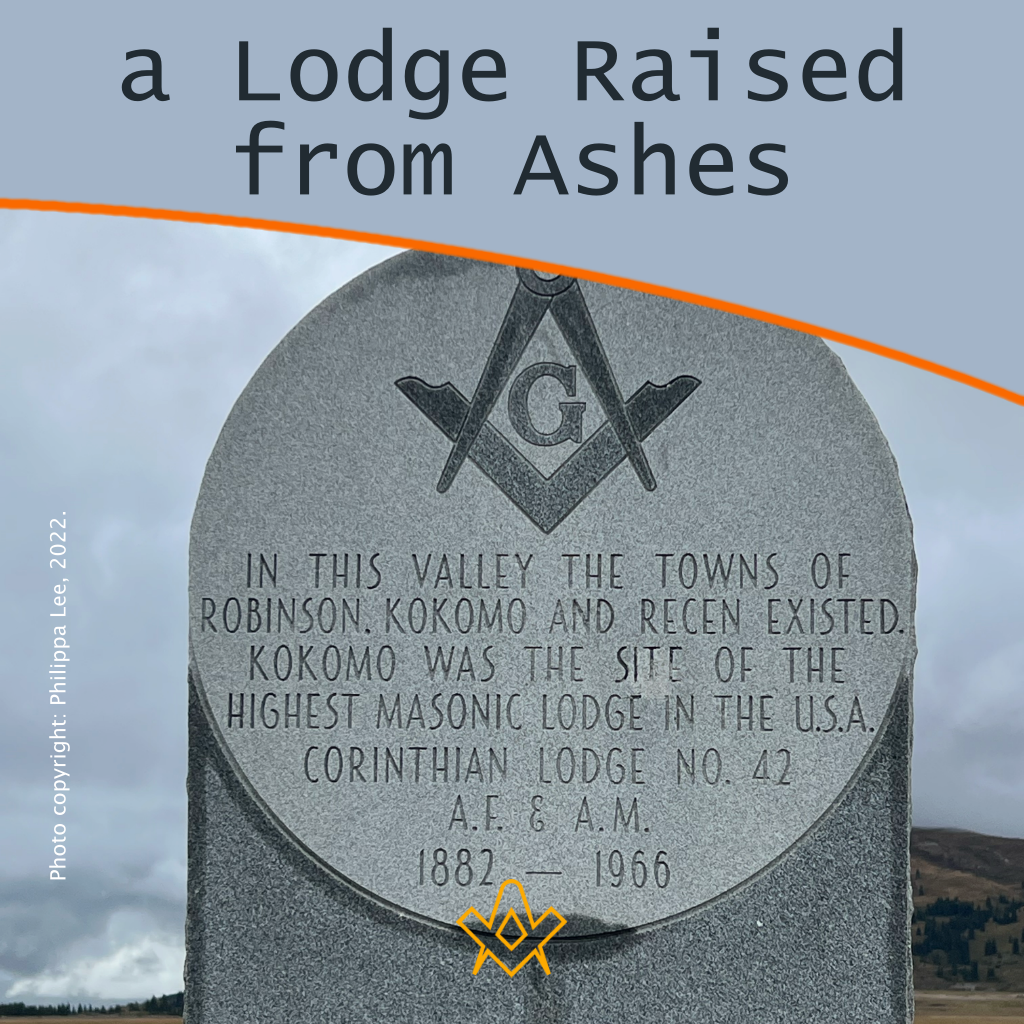Blink and you’d miss it, but driving on switchbacks and blind bends through the Colorado Rockies had made me more observant than usual and I was already on high alert for anything that would pique my interest.
So when I glanced at what seemed to be an innocuous marker stone at the side of Colorado State 91 near Leadville, my brain decided to inform me that it had Masonic connections.
Years of studying, researching, and writing about Freemasonry must have etched the symbol of the square and compasses firmly into my subconscious.
‘That stone was Masonic!’
My partner didn’t even raise an eyebrow, he had become used to my sudden excited outbursts. ‘Do you want to go back? I’ll look for somewhere to turn.’
Somewhere to turn on hairpin bends is a feat in itself. But this guy is a pro; a retired police officer unfazed by pulling a precarious U turn, which we achieved quarter of a mile later on a slip road that snaked down to a mine.
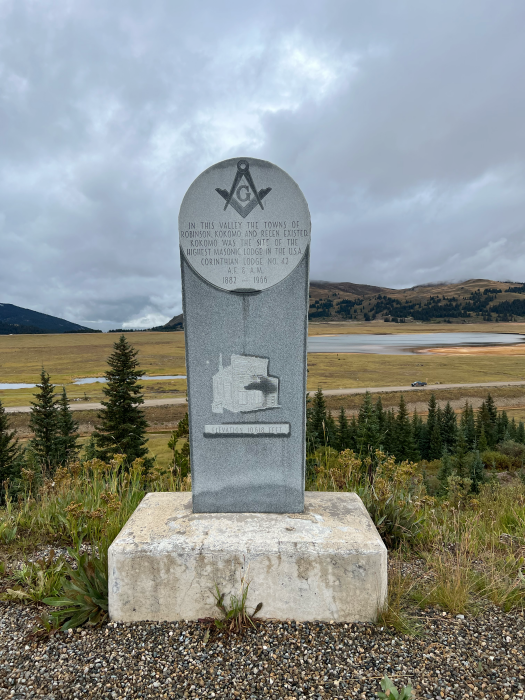
The Masonic Marker stone on Colorado State Highway 91 near Leadville.
IMAGE LINKED: Photo copyright: Philippa Lee, 2022.
Retracing our route, we crunched slowly onto the gravel layby overlooking Robinson Lake.
The marker stone was indeed Masonic – storm-grey granite, perched about four feet high on a pedestal within a fenced in area.
Commanding in its view of the valley beyond, elegantly engraved with the square and compasses, and an image of the original lodge building. On it was the following humble inscription:
In this valley the towns of Robinson, Kokomo and Recen existed.
Kokomo was the site of the highest Masonic lodge in the USA.
Corinthian Lodge No. 42
A.F. & A.M.
1882 – 1966
In the mid-nineteenth century Kokomo in Summit County, Colorado, took its name from nearby Kokomo Gultch, which in turn was named after Kokomo in Indiana.
The Pike’s Peak Gold Rush trickled into the area in the 1860s, when placer gold was discovered. Prospectors arrived in earnest, and subsequently discovered vast deposits of silver in an area known as Tenmile Valley.
More intensive mining was only established in 1877 after lead-zinc-silver ore became the main resources in the nearby mining town of Leadville. From this influx of treasure seekers, the community of Kokomo was born.
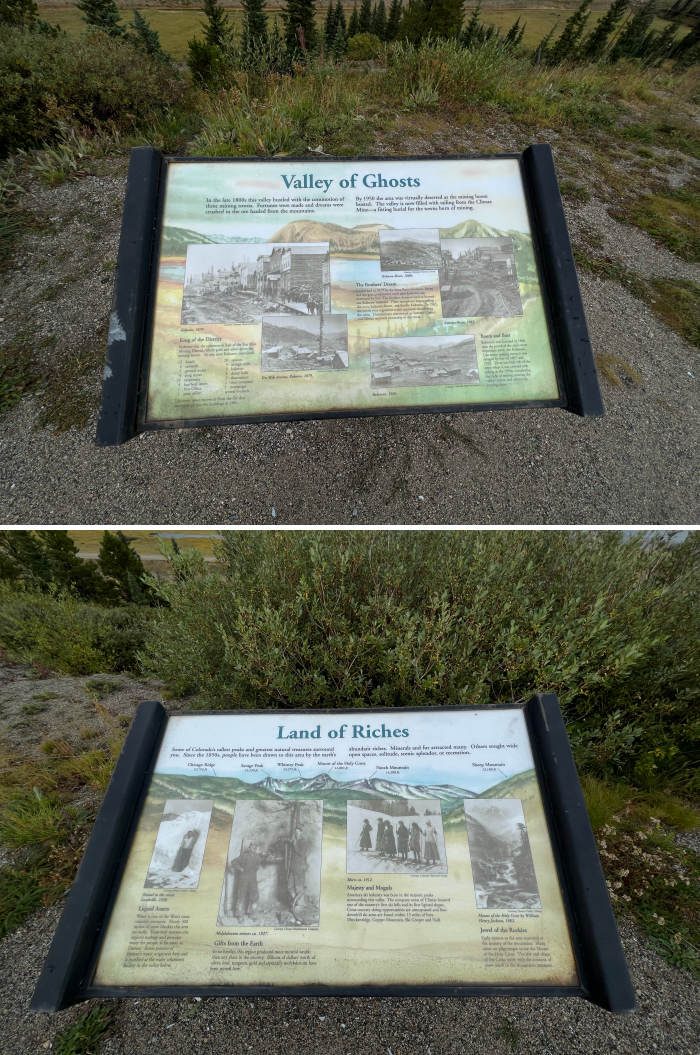
Information boards next to the Masonic Marker at the overlook on Colorado 91.
IMAGE LINKED: Photo copyright: Philippa Lee, 2022.
In 1879, the small town, consisting of all wood buildings, was razed by fire. The tenacious townsfolk rebuilt Kokomo and an all important feature – the post office – was established.
A letter dated May 31st, 1880 (a year prior to a second fire in 1881) from prospector T. D. Armstrong to his mother, describes the mining camp at Kokomo:
Kokomo is situated in Ten Mile Creek, six miles from the summit of the snowy range on the Pacific Slope.
It is claimed to be the highest city in the world, its elevation being over 11,000 feet above the level of the sea.
The original town of Kokomo. Built entirely of logs was destroyed by fire in March 1879. The present city is built mostly of substantial frame buildings, very few of which are painted.
There were two sawmills, one planing mill, four blacksmith shops and all other enterprises incident to a new mining camp are fully represented.
T. D. Armstrong, Kokomo, Col. May 31st, 1880. [Source: ghosttowns.com]
By 1881, there are records that indicate Kokomo was booming with a population of around 10,000.
Sadly, it seemed lessons were not learnt from the previous fire, and the town burned once again that same year, leading to a general steady decline and a merger with the adjacent mining community of Recen.
Corinthian Lodge No. 42 –a Lodge raised from the ashes
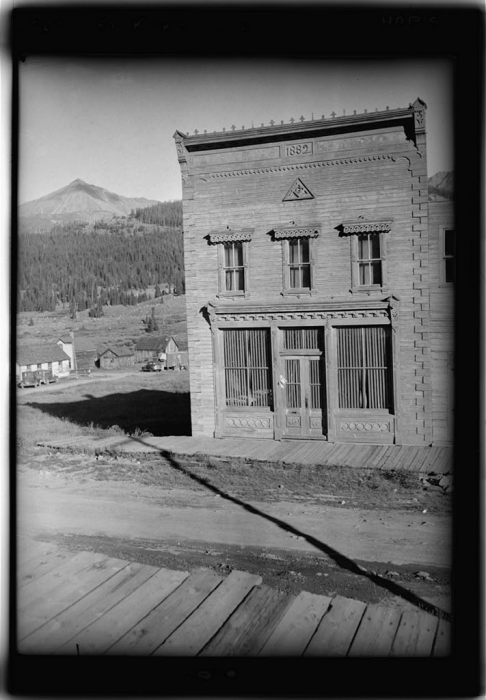
Historic American Buildings Survey, C., Welles, F., photographer. (1933)
Masonic Temple, Kokomo, Summit County, CO. Summit County Kokomo Colorado, 1933. Documentation Compiled After.
[Photograph] Retrieved; from the Library of Congress, https://www.loc.gov/item/co0029/
One important part of the community of Kokomo that was raised from the ashes of the 1881 fire was Corinthian Lodge No. 42.
The timeline of the lodge has been documented by the Grand Lodge of Colorado A.F. & A.M. and Longmont Freemasons
On April 16, 1881, a dispensation was granted to Corinthian, No. 42 and sponsored by Ionic Lodge No. 35 of Leadville.
The officers were John N. Harder, W.M.; F. H. Sutherland, S.W.; Albert L. Ordeau, J.W.; and B. C. Ross, Secretary.
Their first meeting U.D. was May 3, 1881. On September 19, 1881, the Charter was read and Corinthian Lodge No. 42 duly opened by J. M. Fox acting for Grand Master Robert A. Quillian.
On Oct. 13, 1881 a disastrous fire destroyed the biggest part of Kokomo including the Lodge Room.
On Jan. 11, 1882 with a special dispensation from Ionic Lodge No. 35, the lodge was convened and an election held. A regular meeting was held on Jan. 21, 1882 and business resumed.
On Aug. 15, 1882 the Brethren rented the Odd Fellows Hall and meetings were held there until September 18, 1888 when the present Temple was purchased.
During 1888, No. 42 bought furnishings and refurnished the building; then the Odd Fellows rented from them.
The dining room has been used for a church, voting place, parties and dances, also for an evening school and a post office.
Bro. Ben F. Rich is the one Mason most responsible for not allowing the Charter to lapse, during the lull of mining activities in the area when the resident membership dropped to a minimum of one.
M.W. Grand Master Alphonse A. Burnard visited on July 24,1900.
In December 1933, it was found that the acting Treasurer had taken all the money but $6.00. However, he deeded his home to the Lodge and the loss was recovered.
On May 25, 1943, Grand Master Howard T. Vaille visited No. 42 and told the Master to “hold on to that Charter” and with the help of lodges of Leadville, Breckenridge, Eagle, Minturn and Fairplay it has been done.
This Lodge is the highest in the world except the one in Peru, South America. Many railroads have made their appearance at Kokomo but there is none now.
Also of the many Custom Mills and Smelters which were in operation nearby, none remains. At present there are a few mills cutting mine timbers for the mines which are operating.
[Source: longmontmasons.org]
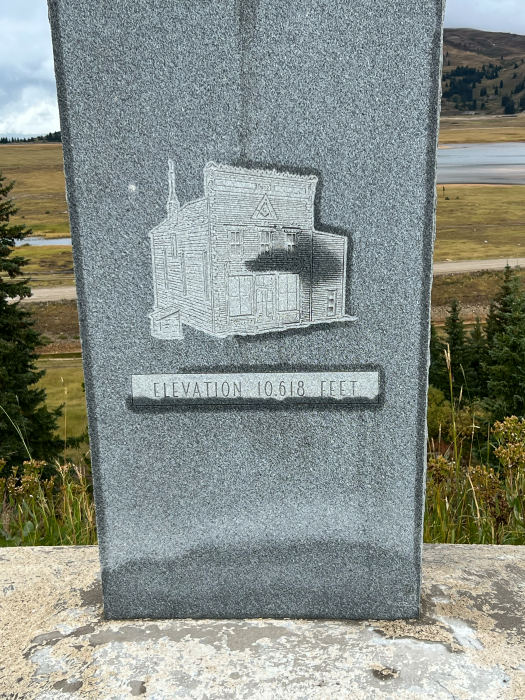
Masonic Marker Stone depicting the old Kokomo Masonic Lodge Building, which stood at an elevation of 10,618 feet.
IMAGE LINKED: Photo copyright: Philippa Lee, 2022.
During the 1890s, Kokomo was – at 10,618 feet above sea level – the highest elevated town of any in the state, and so Corinthian Lodge No. 42 has the historical record of having been the ‘highest Masonic lodge in the USA’, and the second highest in the world!
Longmont Freemasons wrote this wonderful tribute in their centennial history of Freemasonry in Colorado:
Corinthian, No. 42 of Kokomo not only can boast of being the highest Lodge in the United States, elevation 10,618 feet, but also of having had a Master with one of the longest services on record.
Benjamin F. Rich refused to let the Lodge die though the area was depopulated, and the membership dropped to as low as twelve.
W. Bro. Rich enlisted the cooperation of the Grand Lodge so that an annual meeting could be held to maintain the charter.
When he was presented with a 5O-year pin and Colorado Certificate in 1942, Grand Secretary Patton noted that W. Bro. Rich had been Master for twenty-four of the 50 years.
Charles L. Young, Grand Lecturer, was impressed with the surroundings and effort. In 1936 he said:
“The hall was lighted by old oil lamps, the Temple was built of logs, the furniture was several generations old, and without any stretch of the imagination, we were taken back to the early days in this jurisdiction.
We speak off-hand of the antiquity of our Craft but to have these facts brought home, it is necessary to attend a meeting of this type.
Statistics are dry reading, historical dates are easily forgotten, but a contact with the past through personal touch stays long in the memory.
We sincerely hope that the little Lodge at Kokomo, headed by its beloved Master, W. Bro. Ben F. Rich, may continue to keep the torch lighted on the highest hill that we in the lowest valleys may take heart.”
[Source: longmontmasons.org]
Again in 1955 he commented:
“This Lodge has only one resident member. It owns its own Masonic Temple which has been reconstructed inside by their own manual labor. The officers have to drive many miles in order to get together and learn their work. They know and perform their work exceedingly well. When I made an official visit to this Lodge there were 24 members of the Lodge present who had driven from as far as Salida on the west to Olney Springs on the east and they had 22 visitors who likewise had driven many, many miles. This year they raised five of their own candidates.”
[Source: longmontmasons.org]
Like most of the mining communities, Kokomo’s silver bubble gradually burst, mines in the area closed and inhabitants moved elsewhere in search of new lives and work.
However, even with Kokomo in decline, Corinthian Lodge still had a considerable membership. Charles Young ended his commentary above, by stating:
Loyalty of the members and widespread cooperation of other brethren have united to give Corinthian a current, membership in 1960 – 151.
[Source: longmontmasons.org]
Corinthian Lodge No. 42 – a lodge with altitude – ceased to exist after 1966; no doubt the remaining members consolidated with lodges in nearby Leadville, or Breckenridge.
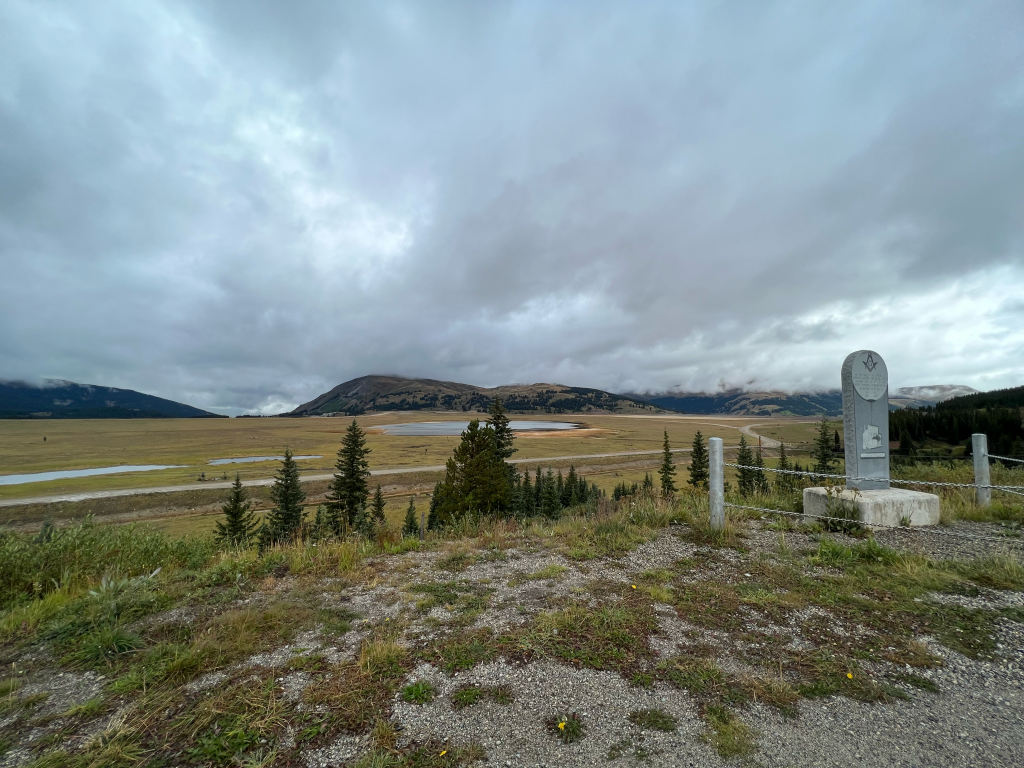
Remnants of a ghost town – Robinson Lake and the Tailings Pond are all that remains of the mining communities of Kokomo, Recen, and Robinson
IMAGE LINKED: Photo copyright: Philippa Lee, 2022.
By the mid-1960s, Kokomo’s post office closed its doors for good, and the population was close to zero. The land was bought by Climax Molybdenum Company who then began to use it for dumping ‘tailings’ in the 1970s.
Today, visible in the valley beyond the marker stone are Robinson Lake and the Robinson Tailings Pond – the only remnants of a former boom town, which became just one of America’s many ghost towns.
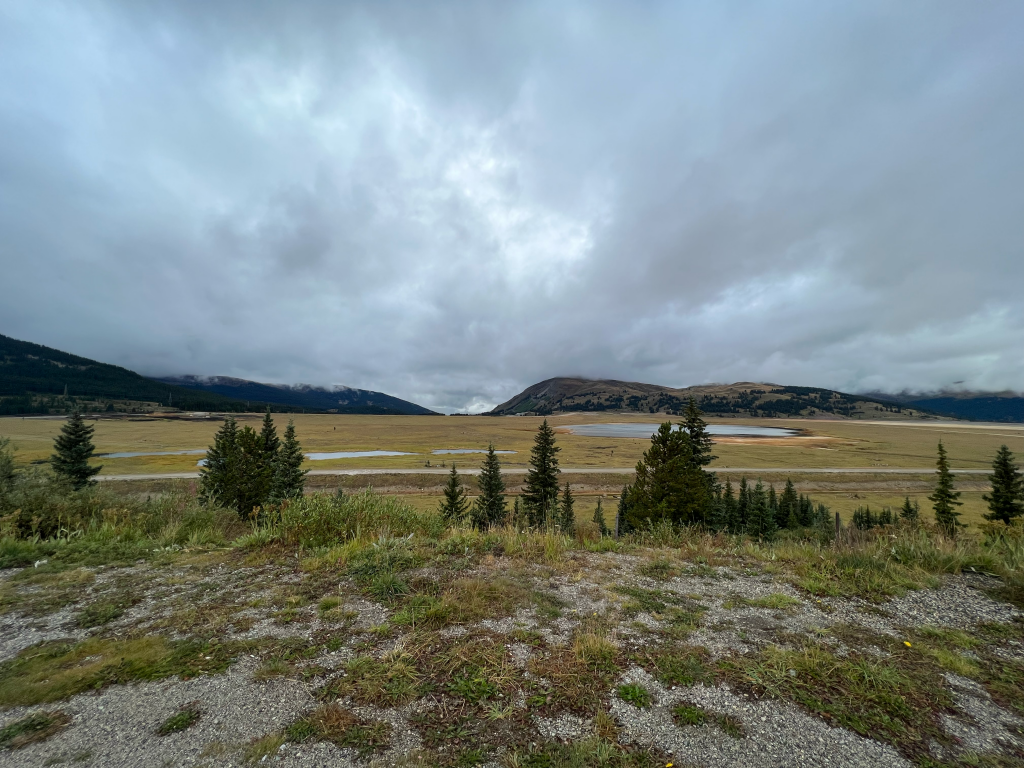
Remnants of a ghost town – Robinson Lake and the Tailings Pond are all that remains of the mining communities of Kokomo, Recen, and Robinson
IMAGE LINKED: Photo copyright: Philippa Lee, 2022.
Further reading / resources:
Paper – ‘Freemasonry in Pike’s Peak Country‘, Ben Williams, AQC 2021 (PDF)
For fascinating photographs of Kokomo and Recen in the 1800s/1900s
Article by: Philippa Lee. Editor

Philippa Lee (writes as Philippa Faulks) is the author of eight books, an editor and researcher.
Philippa was initiated into the Honourable Fraternity of Ancient Freemasons (HFAF) in 2014.
Her specialism is ancient Egypt, Freemasonry, comparative religions and social history. She has several books in progress on the subject of ancient and modern Egypt. Selection of Books Online at Amazon

Freemasonry on the Frontier
Edited by Dr John S. Wade
A collection of seventeen original papers by leading Masonic researchers and academics tracking the evolution of Freemasonry in America from the original thirteen colonies to the Pacific Coast.
Contributors include Ric Berman, Brent Morris, Mike Kearsley, Barry Hoffbrand, John Wade, Adam Kendall, and Andreas Önnerfors, members of Quatuor Coronati Lodge,
and a number of outstanding American scholars: Ben Williams, Hilary Anderson Stelling, Hans Schwartz ,John Kyle Day, Jeffrey Croteau, Andrew Hammer, Daniel Gardiner, and Walter H. Hunt,
as well as two brilliant European writers, Peter Lanchidi from Israel and Leif Endre Grutle from Norway
Recent Articles: masonic history
 Protestantism and Masonic Influence in Brazil Discover the untold story of how Freemasons helped Southern Americans immigrate to Brazil post-Civil War, fostering economic and educational growth in Santa Bárbara d’Oeste and Americana. Learn about their pivotal role in establishing Protestant churches and ensuring the secularity of the Brazilian State amidst a Catholic-dominated society. |
 Explore the proper use of the sacred word in Brazilian Freemasonry through an analysis of Masonic literature and Bible translations. Uncover the errors in pronunciation and the need for corrections to maintain liturgical coherence in rituals. Discover insights on Masonry, rituals, and the Hebrew word Boaz. |
 Narratives of History |
 A Very Royal Sesquicentenary |
 Unveiling the Enigma: Discover the Royal Society's Legacy and its Impact on Science. Delve into the fascinating history of the Royal Society, the prestigious UK academy shaping scientific progress since 1660. Explore its pivotal role in advancing knowledge, fostering collaboration, and unlocking the secrets of the universe. Prepare to be amazed! |
 Knights Templar in Freemasonry Uncover the Mysteries of the Knights Templar in Freemasonry! Delve into the intriguing world where chivalry and symbolism intertwine. Discover the captivating rituals and ancient secrets behind the Knights Templar Masonic Orders. Explore the historical connection and delve into the enigmatic narratives that continue to fascinate enthusiasts today. Unveil the hidden truths now! |
 The Royal Arch stands as the rainbow of promise in the Ritual; it stands as the promise of the resurrection; of that which was lost and that it shall be recovered. The question arises as to whether the Master's Word was originally communicated in the Third Degree? On this point there is some diversity of opinion. Originally published in 1915, this insight into the Fourth Degree – the Holy Royal Arch – is as relevant today as it was over 100 years ago. |
 Unveiling the Mysteries of Druidism: Discover the Intriguing Connection with Freemasonry. Explore the ancient spiritual practice of Druidism and its fascinating ties to the enigmatic world of Freemasonry. Delve into the shared symbolism and rituals that have captivated minds for centuries. Unlock the secrets of these intertwined traditions today! |
 Uncover the legacy of freestone masons and their pivotal role in crafting medieval cathedrals. Discover the artistry behind their techniques, the hierarchy within their craft, and the enduring impact of their intricate carvings. A deep dive into the world of these master craftsmen awaits you! |
 Unearth the intriguing journey from Vincha Culture to Freemasonry. Discover how ancient building methods intertwine with modern Masonic philosophies. This exploration will shed light on the fascinating link between the Serbian term "shestarenye" and the symbolic significance of the compass in Freemasonry. |
 Freemasonry and the Illuminati Unravel the enigmatic world of Freemasonry and the Illuminati in our latest exposé. Dive into centuries-old mysteries, debunk conspiracy theories, and discover the truth behind these elusive societies. Are they puppet masters or mere myths? Join us as we dissect history and fact from fiction. |
 The Île des Templiers, or “Island of the Templars” lies within a leafy park in Paris. The execution site of Jacques du Molay, the last Grand Master of the Knights’ Templar bears a plaque with the epitaph ‘A cet endroit / Jacques de Molay / Dernier grand maître / de l'ordre du temple / a été brûlé le 18 Mars 1314’ (‘In this location / Jacques de Molay / Last grand master / of the order of the temple / was burned on 18 March 1314’) |
 Operative Progressions to Speculative Masonry Both Operative and Speculative Masonry are an important part of the modern fraternity of Freemasonry, which combines elements of both traditions. Today, Freemasonry is a fraternity that is open to men of good character, who are interested in personal development and in making a positive contribution to their communities. |
 General Regulations of a Free Mason, 1723 General Regulations of a Free Mason as contained in Anderson's Constitutions of the Freemasons, published 1723. the Regulations are of great historical interest. Compiled by George Payne, the second Grand Master of the Premier Grand Lodge of England, they were printed in 1722/3, thus published just over five years after the formation of the Grand Lodge 1717. |
 The Genesis of the 1723 Book of Constitutions 2023, marks the three hundredth anniversary of the publication of the first printed Book of Constitutions of the Grand Lodge formally established in London two years previously. This is an anniversary whose significance extends beyond freemasonry. A paper by Andrew Prescott |
 The Ritual of the Operative Free Masons - P3 Existing Operative Free Masons. The ritual I am about to refer, is that of "The Worshipful Society of Free Masons, Rough Masons, Wallers, Slaters, Paviors, Plaisterers, and Bricklayers." By Thomas Carr, M.D., P. M. Honorary Member of the Guild of Operative Free Masons |
 Liberté chérie was a Masonic Lodge founded in 1943 by Belgian Resistance fighters and other political prisoners at Esterwegen concentration camp. It was one of the few lodges of Freemasons founded within a Nazi concentration camp during the Second World War. |
 The Ritual of the Operative Free Masons - P2 If anyone doubts the fact that the formation of Speculative Free Masonry was due to and based upon Operative Free Masonry, it is quite easy to convince him of his error if he will only study the first Book of Constitutions. By Thomas Carr, M.D., P. M. Honorary Member of the Guild of Operative Free Masons |
 In 1881, Freemasonry rose from the ashes of a fire in the mining town of Kokomo, Summit County, Colorado. Corinthian Lodge No. 42, along with Kokomo, no longer exists but it holds the record of having been – at an elevation of 10,618 feet – the highest Masonic Lodge in the USA. |
 The Huguenots and Early Modern Freemasonry The Huguenots influence in the development of early modern Freemasonry at the time of the formation of the Grand Lodge in London around 1717 / 1723. |
 November is a month of reflection – perhaps due to the fact that we are getting close to the years' end – but also because Remembrance / Armistice Day (11 November) is a significant date in most countries' diaries. |
 Speculative Freemasonry, as practise by Grand Lodge of England, was officially born just over three hundred years ago, is today an international organisation, counting over six million members. It has been subjected to persecution, suppression, and abolition throughout its history. In its infancy, only a couple of decades after its official birth, it had already become a target. |
 The Ritual of the Operative Free Masons - P1 The original paper was written, first, to prove that Speculative Free Masonry was derived from Operative Free Masonry; second, to give some account of the Operative Free Masons, of their Ritual, and of their customs. By Thomas Carr, M.D., P. M. Honorary Member of the Guild of Operative Free Masons |
 American Fraternalism in the 19th and Early 20th Centuries The late 19th and early 20th centuries in the United States has been called the "Golden Age of Fraternalism." How did this come about and why was the idea of joining a fraternal organization so popular? We will explore this question and examine the regalia used by many fraternal organizations in this period. |
 Societas Draconistarum, meaning "Society of the Dragonists"– was a chivalric Order for selected nobility, founded in 1408 by Sigismund von Luxembourg, who through marriage became the King of Hungary (1387–1437) and later Holy Roman Emperor. The Order was fashioned after the military orders of the Crusades, requiring its initiates to defend the cross and fight the enemies of Christianity, in particular the Ottoman Empire. |
 The Perjured Free Mason Detected Was Samuel Prichard a perjured individual, or simply a misguided Freemason? Prichard's book "Free Masonry Dissected" published in 1730, is now used by many Masonic historians as a source of reference with regards to the introduction of the third degree into the Craft. But at the time it was published in 1730, it was not so well received by members of the Grand Lodge of England. |
 17th century and the Holy Royal Arch This article focuses on a period of transition between a point in time when we can safely and historically identify the first formation of what could be called as the ‘Royal Arch’ and the historical events that have preceded it. |
 Most Freemasons have heard the terms 'Operative' and 'Speculative' Masons, and this article helps to understand the difference: |
 Roberts' Constitutions of Freemasonry 1722 Published a year before Anderson's Constitutions, The Old Constitutions Belonging to the Ancient and Honourable SOCIETY OF Free and Accepted MASONS. Originally printed in London England; Sold by J. Roberts, in Warwick-Lane, MDCCXXII.(1722) |
 From 'Songs of religion and life', 1876 by John Stuart Blackie (1809-1895) |
 On the Antiquity of Masonic Symbolism Is the Symbolism of Masonry an inheritance derived from the old Masons who flourished before the era of the Grand Lodges (1717); or has it been borrowed from the Rosicrucians or others, after 1717? |
 Mason's Marks – from Egypt to Europe? Mason's marks have been a source of intrigue, not only to Freemasons but to historians and archaeologists. The use of simple pictograms have been employed for millennia by artisans to identify their work. But where did they originate and why? |
 The White House Foundation Stones Further to the articles in our series on the history of the stone masons, we have a rather intriguing addition. During the 1950's renovation of the White House, President Truman retrieved more than 100 stone blocks with stonemasons marks. |
 What the Goose and Gridiron Tavern is in the ancient annals of London Freemasonry, The Green Dragon Tavern is to the memories of the Free-mason, of Boston and New England. |
 Auschwitz concentration camp: video photo article taken in 2013 |
 There are two things of importance happening this day - 27 January |
 Two approaches regarding the understanding of Freemasonry |
 Masonic Research in England c1930 An article which appeared in an American Masonic magazine, c1930 and which was reproduced in England, provoking a little controversy. |
 Masonic bookplates the ‘Brethren’s spiritual coats of arms and marks’ |
 The Unlawful Societies Act of 1799 Rebellious Freemasons and the 21st century |
 In 1912, Sarah Dowd of Dromore, Ireland, found a Masonic jewel dated 1517 - a date two hundred years before the establishment of Grand Lodge... |
 Freemasonry and Fascist Regime Interesting speech by the famous historian Prof. Aldo A. Mola, who links the fascist regime with the Masonic Associations. |
 Was famous Russian poet Alexander Pushkin a Freemason? And if so, was he a member of the lodge ‘for which all the lodges in Russia were destroyed’? |
 The Importance of Masonic Research Why is accurate - or authentic - Masonic research so important? The importance of making a daily advancement in Masonic knowledge is something that The Square is passionate about promoting. |
 The Antient Noble Order of the Gormogons had a brief existence in the eighteenth century; they left few records or accomplishments, |
masonic knowledge
to be a better citizen of the world
share the square with two brothers

click image to open email app on mobile device



